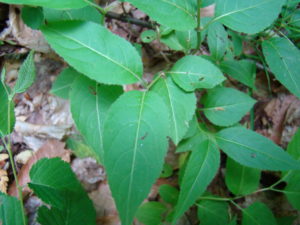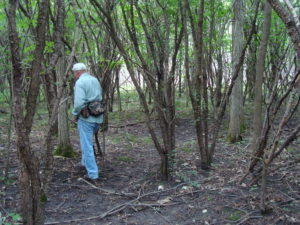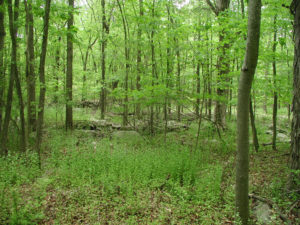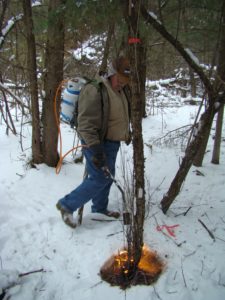Strategies to Control Undesirable and Interfering Vegetation in Your Forest
On most wooded properties, the owner will recognize the presence of at least a few undesired plants species.

This native honeysuckle (Diervilla lonicera) has no interfering qualities, although other species of honeysuckle can become problematic. Photo by Peter J Smallidge.
In some cases, these plants become sufficiently abundant and interfere with the owner’s objectives. Interference might include the development of a beech or fern understory that impedes oak or pine regeneration; hardwoods that interfere with the establishment and growth of conifer forests; or invasive shrubs that reduce the diversity of native plant species. In situations of overabundance, the owner may need to control the interfering plant to more fully achieve his or her objectives.

A productive hardwood forest, reverted from an abandoned agricultural field. Photo by Peter Smallidge.
Landowners should resist the temptation to grab a saw, brush loppers, a bottle of herbicide, etc. and head out to do battle against the undesirables. We all have limited time, experience, ability, equipment, and money to commit to “weed” control, so it is wise to plan ahead to make the most of our efforts! Each situation of interfering plant control is somewhat unique, so a set of guiding principles will help owners consider the range of management strategies.
Strategic Goals
Landowners should consider the following factors when planning for control of interfering plants:
- Efficient use of labor, energy and equipment
- Cost effective to minimize the consumption of tools, supplies and especially time
- Targeted control of the interfering plants with minimal damage to desired plants
Integrated vegetation management, or IVM, is the approach that incorporates these management goals in a framework that allows optimal control of interfering plants. IVM originated with plant management on power utility corridors, but its principles apply to private lands.
The foundation for effective IVM is a situation profile that includes knowledge of: plant biology, the extent of the plant problem, the desired level of control, and an estimate of the costs (equipment, supplies, and time). The owner and manager should consider these four elements of the profile before commencing any treatment of the vegetation. Not considering these elements may result in unnecessary cost, undesired damage to desired plants, excessive use of herbicides or wasted labor and supplies, and ultimate failure to control the target plant(s).

Land managers need to understand the biology of the species they hope to control. Biennial plants, such as the garlic mustard (Alliaria petiolata) pictured, or woody shrubs may have one or more years of vegetative growth before they produce fruit. Photo by Peter Smallidge
IVM Situation Profile and Vegetation Treatments
- Plant Biology – Identify the plant, understand its life cycle, reproductive strategy, and any mechanism that the plant uses to store propagules or energy reserves. Give special attention to what allows the interfering plant to be successful.
- Extent of the Problem – The geographic extent of the problem plant on the property being treated and within the landscape will influence the likelihood of reintroduction, the operational efficiency of potential treatments, the likelihood of treatments affecting viable non-target species, and the amount of disturbance and open space following the treatment.
- Desired Level of Control – Complete annihilation of a species is a difficult task. In many cases, ownership objectives can be satisfied with less than 100% control of the target plant. However, any residual plants may allow for spread into the treated areas. Some objectives may be satisfied with spatial control (e.g., within rows for a plantation) or control for a period of time to allow other species to become established.
- Costs– Costs include the actual financial cost of the materials and labor, the ecological costs associated with the treatment, the ecological costs of not controlling the undesirable plant, the cost for re-treatment if the initial effort fails, and the risk to the staff applying the treatment. Failure to plan to successful re-vegetation with desired species is an added future cost.
IVM treatments can be described by mode and method (Table 1). Mode is the specificity of the treatment to the target and is either broadcast or selective. Method is the mechanism that allows the treatment to limit the plant and includes mechanical, chemical and biological. Each treatment is a combination of mode and method, the choice depends on the profile of the target plant. Each method functions differently to control target plants. Mechanical methods remove the plant and thus future propagules. This removes the plant, depletes the root energy reserves as plants attempt to resprout, and limits the ability for on-site reintroduction. Chemical methods disrupt biochemical pathways by changing the plants’ ability to, for example, regulate growth hormones or form enzymes used in photosynthesis. Biological methods include a variety of host-specific insects, fungi, viruses and bacteria that limit the success of the target plant to grow and reproduce.
All the advantages (Table 2) and the disadvantages (Table 3) may not apply to each situation, but should be considered. The integration of ownership goals and IVM situation profile determine the combinations of methods and modes to consider. Use the treatment that is least intrusive and has the lowest environmental impact, but that gives an adequate level of effectiveness and efficiency. Managers should independently scrutinize each situation, assess the likelihood of potential advantages and disadvantages, and discuss treatment options with the owner (if not
Table 3. Potential disadvantages of method-mode approaches to vegetation managementyour land) to achieve management goals with minimal costs.
Hypothetical Example
Here is a hypothetical example of IVM in practice.
- Profile – multiflora rose (Rosa multiflora) has invaded a 60-year-old hardwood forest. Positive identification confirms it is not a desired species. The plants have an average height of over 5 feet. The shrub’s abundance has reduced wildflower diversity and will restrict the future regeneration of desired hardwoods. The shrub has reduced access by the owner into this section of the woods. A moderate to large deer herd is likely helping to favor the multiflora rose (not heavily browsed) over desired species. The shrub dominates 15 acres of the property and has spotty but limited presence in other areas. The manager recommends at least 90% control, sustained for 10 to 12 years, to ensure successful hardwood natural regeneration. The desire to control the shrub is fairly high and the owner wants to avoid a prolonged treatment period.
- Response Selected– The owner and manager want to minimize the use of herbicides, but recognize that some herbicide will be needed to kill the root system in an effort to minimize soil disturbance. They opt for a combination of selective mechanical and selective chemical treatments. The prescription involves cutting the shrub and applying an appropriate herbicide to the freshly cut surface of the stump (NOTE – check with your local office of Cooperative Extension for assistance in the selection and application of herbicides). The owner has the equipment and labor necessary to apply this type of treatment at a reasonable cost. The cut stems will be left clustered but not piled in an effort to impede the access of deer to the area and minimize their impact. Further, the owner works with hunters on his property and neighbors to increase the harvest of female deer. Initial IVM efforts will concentrate in the main area of infestation, but also expand to scattered shrubs. In future years, the owner will pull small shrubs as they are noticed or apply a selective foliar herbicide to areas having numerous small scattered multiflora rose shrubs. A forester has developed a prescription to open the forest canopy to increase sunlight and further aid in hardwood seedling regeneration.
- Why not other treatments – Each situation is different and the treatments used by one owner might not work in the future or might not work for the neighbor’s need. The owners and managers decided against selective foliar herbicide sprays because these would not have been as effective given the shrub’s abundance and height. Repeated cutting would not sufficiently control the shrub and would have required repeated entry that the owner did not have time to complete. Grubbing and excavation was deemed too disruptive to the soil in this location. Controlled grazing with silvopasture principles would work, but the owner lacked access to livestock or funds for fencing.
The complexity of IVM rests primarily in understanding the biology of the plant and the relative merits of the different treatment options. Most owners will benefit from the advice of foresters or others trained and experienced in plant biology and vegetation management. Consult with your state’s forestry agency and Cooperative Extension Service to help identify people who can help. A recorded web conference of IVM, including descriptions of several problem species, is provided here




